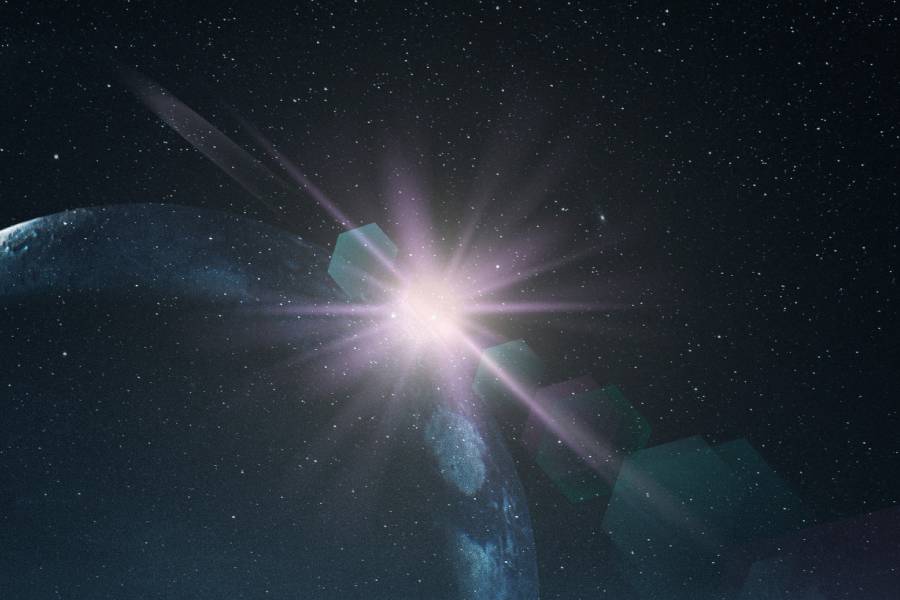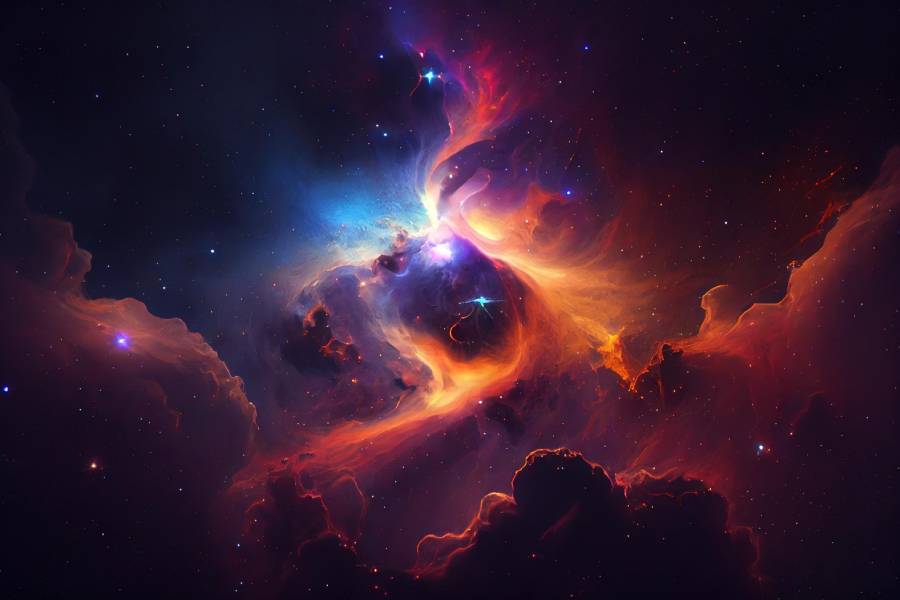Imagine clouds of gas and dust scattered across deep space. They slowly twist due to gravity’s pull, set to create new stars. In dense parts of these gas clouds, protostars appear as gravity makes matter collapse, forming brand-new baby stars. But what is a protostar? What does a protostar look like?
We’ll explore the detailed life cycle of protostars – how these young stars come from cosmic clouds drawn together by gravity. They gather matter, steadily progressing toward fusion, growing into mature stars that brightly join the galaxies they inhabit.
So, let’s get started!
What Is a Protostar?
A protostar is an early stage in the formation of a star, where a dense region within a molecular cloud undergoes gravitational collapse.
As material accumulates, it forms a protostar — a hot and condensed precursor to a fully-fledged star. Protostars represent a crucial phase in stellar evolution, transitioning toward nuclear fusion and the birth of a stable star.

Origins of Protostars
Role of molecular clouds
How is a protostar formed? Dense molecular clouds provide the raw materials for protostar formation. These cold, dense regions in interstellar space consist primarily of hydrogen gas molecules. Their gravity causes areas within the clouds to collapse inward, forming cores.
As the molecular cloud cores continue contracting, their interiors heat up. When sufficiently hot and dense, nuclear fusion of hydrogen into helium ignites — marking the birth of a protostar. Surrounding gas continues falling into the protostar, causing it to grow in mass.
Gas clouds and protostar birth
Powerful gravity forces interstellar gas clouds to collapse inward, concentrating matter toward the core. As the cloud spins with conservation of angular momentum, it flattens into a disk-like structure centered around the increasingly hot, dense protostar.
Furthermore, infalling gas crashes into the accretion disk, releasing strong bursts of energy while feeding more matter into the protostar. Complex organic molecules also form amidst the disk’s reactions — seeding future solar systems. This process continues until fusion reactions halt further gravitational collapse.
Sequence of Star Formation
A protostar emerges from its dusty cocoon of gas when fusion begins, entering the pre-main sequence phase while still accreting some material. Over 30-50 million years, protostars contract and eventually halt accretion as thermonuclear reactions provide outward radiation pressure balancing gravity.
In the main sequence, the new star derives energy from fusing hydrogen into helium within its high-temperature core. High-mass stars fuse faster, thus skipping the pre-main sequence phase — their much shorter lifespans end dramatically. Lower mass stars settle onto steadier paths, slowly fusing for potentially trillions of years.
Characteristics of Protostars
Solar masses
Protostars exhibit various masses. These masses range from a fraction to over 100 times the mass of our Sun. Initial mass depends on the molecular cloud core gravity causes to collapse.
More massive molecular cloud cores birth more massive protostars. Stellar mass also grows by the accretion of gas onto the protostar. Moreover, final mass impacts factors like temperature, brightness, and lifespan.
Core temperature
As the core temperature rises, it allows the formation of protostars. Gravity then causes the collapse, heating the center intensely. This can lead to temperatures surpassing 10 million kelvin, triggering nuclear fusion.
Also, the ongoing hydrogen fusion prevents further collapse, creating a stable balance. Over millions of years, the core temperature keeps increasing before finally settling into the main sequence.
Low-mass vs. massive protostars
Low-mass protostars have a mass of less than 2 solar masses. On the other hand, high-mass protostars can weigh anywhere from 8 solar masses to over 100 solar masses. When a protostar is more massive, its core gets compressed faster.
Massive protostars heat up quickly, undergo fusion faster, and stop gathering material rapidly. Consequently, they burn out more swiftly. In contrast, lower-mass protostars contract slowly before achieving a more stable fusion phase, lasting billions of years.
Visible Light vs. Infrared Radiation Emission
Types of radiation
Protostars shine brightly in different types of light. At first, they give off a lot of infrared light because they’re getting warm from gravity squeezing them. As protostars get even hotter, they emit more visible light, especially in the blue and white colors. Eventually, really hot massive stars release ionizing ultraviolet radiation.
Visible light and infrared radiation
As gas and dust fall inward, they conceal younger protostars when observed in visible light. However, longer infrared wavelengths can penetrate through this material. As the collapse of the material progresses, visible emissions start to reflect the increasing temperatures inside.
In the beginning, infrared light dominates, capturing the early energetic processes. Later on, as the protostars approach the main sequence emergence, visible light bands become more prominent, revealing the later phases of development.
T-Tauri Stars
T-Tauri stars represent a key transitional stage for young low-mass protostars nearing the main sequence. Their mass falls between 0.5 to 2 solar masses. The T-Tauri stars have partly condensed but still accrete some gas from their protoplanetary disk.
Furthermore, strong stellar winds emerge as convection develops within T-Tauri stars. They fluctuate irregularly in brightness while contracting over 30 million years. The T-Tauri phase ends once accretion halts, allowing gravitational settling and stabilizing fusion rates.
Impact on Stellar Evolution
Protostars lay the groundwork for a star’s life cycle. The initial mass determines how fast the star evolves and its ultimate fate. Lower-mass protostars take a more consistent path over billions of years. On the other hand, massive protostars, with masses above 8 solar masses, undergo intense fusion for millions of years before meeting a dramatic end.
Moreover, the characteristics of protostars influence all subsequent stages, starting from the main sequence and leading to their demise. They provide the original mass and angular momentum, shaping remnants like pulsars, black holes, and recycled stardust. These remnants, in turn, contribute to the formation of new stars.

Conclusion
The intricate journey of protostars unveils the celestial wonders that shape our universe. So, what is a protostar? It’s not merely a cosmic entity; it’s a testament to molecular clouds’ captivating dance and stars’ radiant emergence.
We unraveled the cosmic tapestry by comprehending the solar masses, core temperatures, and unique characteristics defining protostars. From the glow of visible light to the mystique of infrared radiation, protostars paint a celestial masterpiece.
As we conclude, we hope you have realized that these stellar newborns hold the key to unraveling the secrets of stellar evolution. They invite us to gaze into the vast cosmos with newfound understanding.
